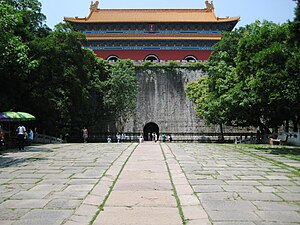Ming Xiaoling
| Imperial Tombs of the Ming and Qing Dynasties | |
|---|---|
| Name as inscribed on the World Heritage List | |
 |
|
| Location | China |
| Type | Cultural |
| Criteria | i, ii, iii, iv, v, vi |
| Reference | 1004 |
| UNESCO region | Asia-Pacific |
| Coordinates | 32°03′37″N 118°50′04″E / 32.060305°N 118.834568°ECoordinates: 32°03′37″N 118°50′04″E / 32.060305°N 118.834568°E |
| Inscription history | |
| Inscription | 2000 (24th Session) |
| Extensions | 2003; 2004 |
The Ming Xiaoling Mausoleum (Chinese: 明孝陵; pinyin: Míng Xiào Líng; literally: "Ming filial mausoleum") is the tomb of the Hongwu Emperor, the founder of the Ming dynasty. It lies at the southern foot of Purple Mountain, located east of the historical centre of Nanjing, China. Legend says that in order to prevent robbery of the tomb, 13 identical processions of funeral troops started from 13 city gates to obscure the real burying site.
The construction of the mausoleum began during the Hongwu Emperor's life in 1381 and ended in 1405, during the reign of his son the Yongle Emperor, with a huge expenditure of resources involving 100,000 labourers. The original wall of the mausoleum was more than 22.5 kilometres long. The mausoleum was built under heavy guard of 5,000 troops.
Da Jin Men and Sifangcheng. One enters the site through the monumental Great Golden Gates (Da Jin Men), and is soon faced by a giant stone tortoise (bixi), which resides in the Sifangcheng ("Square city") pavilion. The tortoise supports a splendid carved stone stele, crowned by intertwining hornless dragons. The well-preserved stele is known as the "Shengong Shengde Stele" (神功圣德碑), i.e., literally, "The Stele of Godly Merit and Saintly Virtue". The inscription of the stele, extolling the merits and virtues of the Hongwu Emperor Zhu Yuanzhang was written by his fourth son, the Yongle Emperor. The tortoise is 5.15 m long, 2.54 m wide and 2.8 m tall, the stele stands 8.78 m tall (including the tortoise) and is one of the best-known examples of its genre.
...
Wikipedia
